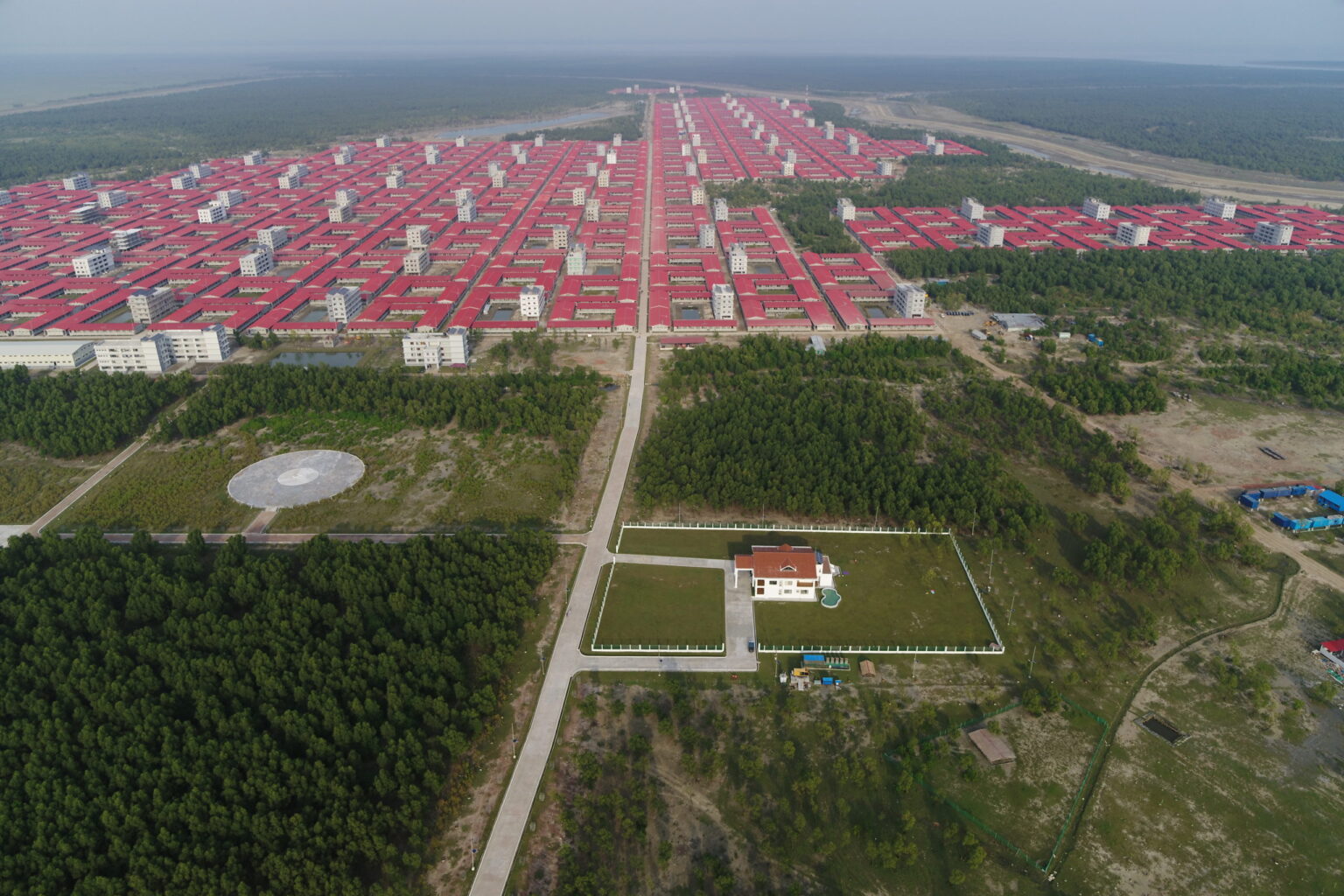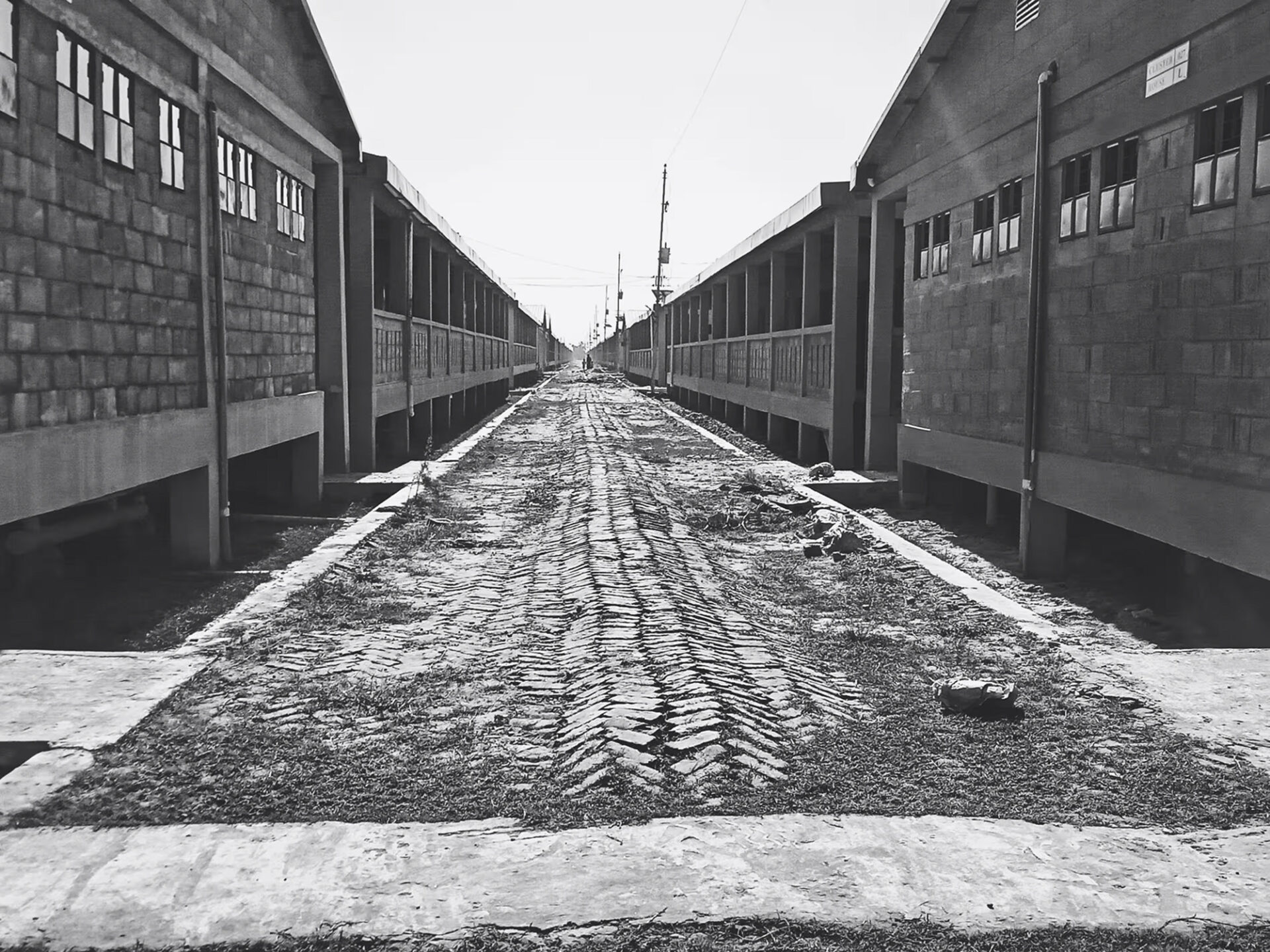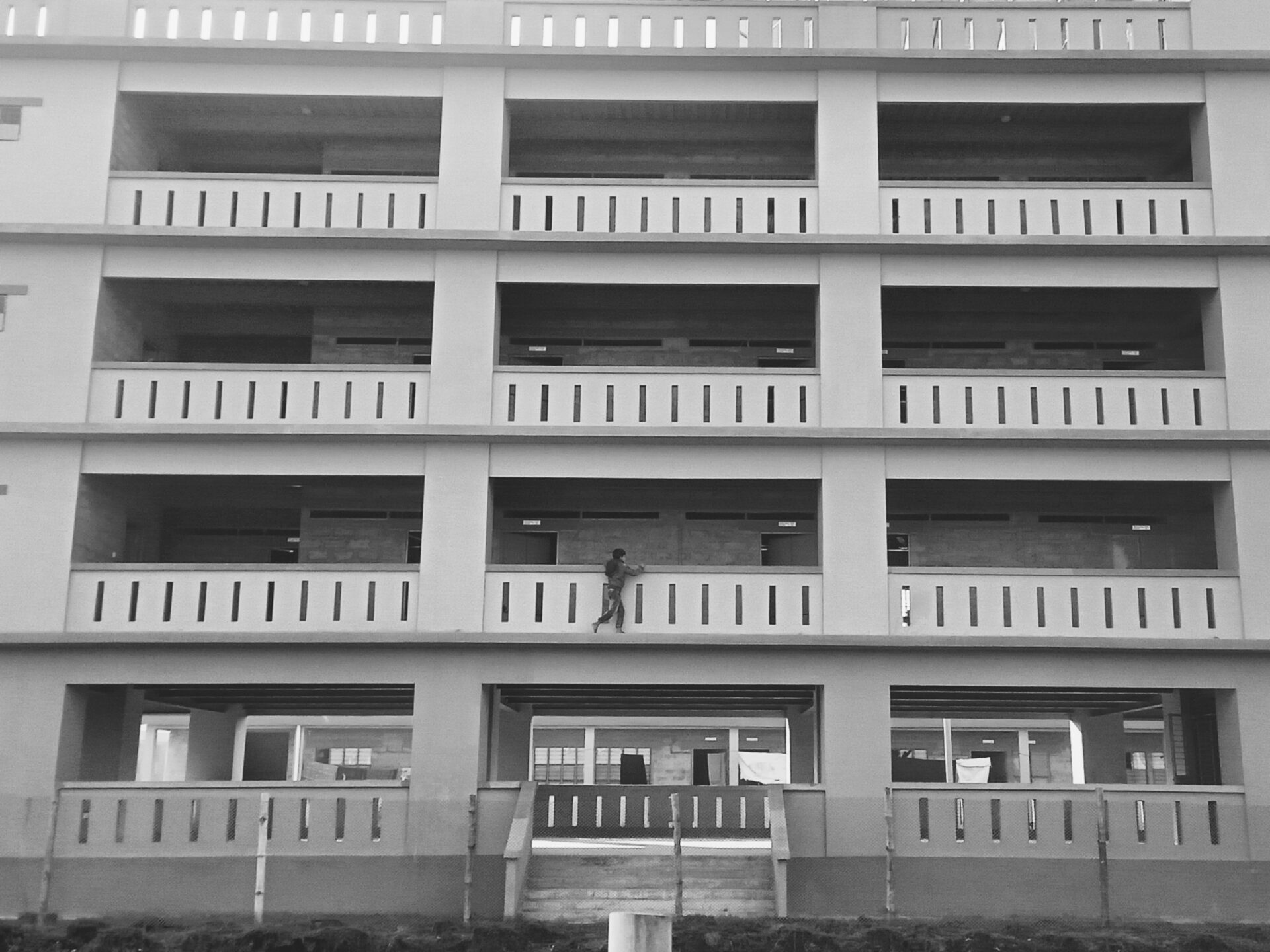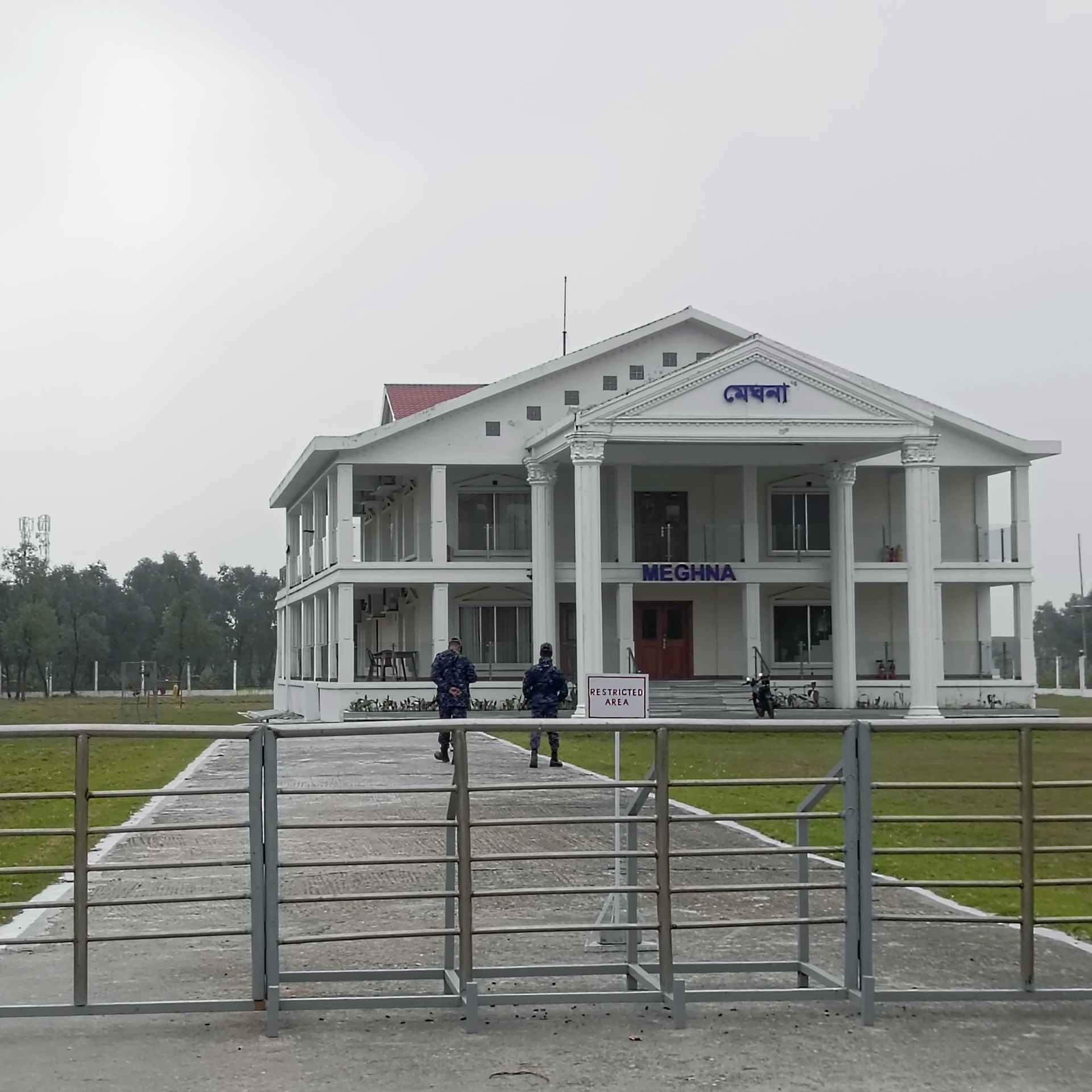This article is part of the FA special series Everywhere Walls, Borders, Prisons.
The Rohingya people have faced waves of persecution and displacement from Myanmar since at least 1978, when the military launched Operation Dragon King to root out so-called “foreigners” from Rakhine State. Since then, repeated campaigns of violence have forced hundreds of thousands to flee across the border into Bangladesh, only to be met with further marginalisation. Rather than providing meaningful support, Bangladeshi authorities – under the Awami League, led by Sheikh Hasina – devised a refugee camp on the island of Bhasan Char as an intensified form of containment within its broader refugee management strategy. In reality, this flood-prone island has become a striking example of authoritarian hubris, in which architecture is deployed to control and confine, while the government falsely claims humanitarian credit.
The Bhasan Char refugee camp was constructed by the government of Bangladesh around 2018 as part of an expansion of the Ashrayan Project, an Awami League initiative originally launched in 1997 to provide housing for the landless. In its third phase, known as Ashrayan-3, the project was adapted to include the relocation of Rohingya refugees to Bhasan Char. The island sits in the Bay of Bengal, formed relatively recently by silt deposits, and highly vulnerable to cyclones and flooding. Officials claim the island can house around 100,000 refugees in neat rows of dormitory-style barracks. Each block shares bathrooms and cramped cooking areas, leaving little room for personal privacy or autonomy. From communal latrines to the substandard water supply and extremely limited access to electricity, the so-called ‘infrastructure’ is worlds away from dignified living. In effect, Bhasan Char is a massive warehouse for what the state perceives as a surplus population: refugees deemed burdensome and disposable.
Though cloaked in humanitarian language, the spatial design of the project betrays its real aim: to warehouse the Rohingya, rather than to provide genuine humanitarian relief. Uniform barracks, heavily monitored checkpoints, and the ever-present security apparatus all confirm the regime’s focus on control over compassion. Bhasan Char’s rigid, institutional layout serves as a physical manifestation of Sheikh Hasina’s top-down governance. The broader legacy of Sheikh Hasina’s regime was marked by corruption, cronyism, and a penchant for splashy endeavours that often enriched a select few. Financial scandals abounded, with state and private banks looted by political loyalists, shaking public confidence. Bhasan Char belongs to that same tableau: a big-budget undertaking sold as a charity project that largely serves political interests and rent-seeking alliances.
Despite repeated concerns from international human rights organizations about the island’s habitability and the forced nature of relocations, the Awami League government pressed ahead, with the development of Bhasan Char. Tasking the Navy with overall responsibility, it enlisted Sinohydro, a Chinese construction firm, and HR Wallingford, a British engineering company, to carry out much of the work. This arrangement reflects a pattern of rent-seeking, as the government channels state funds into projects that reward loyal institutions and private contractors. It also flags up the performative nature of the settlement, with top officials brandishing Bhasan Char as a grand humanitarian gesture, while it conveniently keeps the Rohingya removed from opportunities to make a living and integrate into society on the mainland.
Official promotional material for Bhasan Char is laced with paternalism: a flyer published by the firm responsible for much of the project’s design, Mukta Dinwiddie MacLaren (MDM) Architects, paints an optimistic and misleading picture, describing the settlement as a “Beacon of Hope,” a “safe and transient accommodation,” and a place with “community spaces for socialising and events.” Each of these phrases, however, masks a deeper and more troubling reality. The metaphor “Beacon of Hope” is intended to inspire, but it overlooks the Rohingya’s complete lack of choice in their relocation and the systemic conditions that forced them into such displacement. Similarly, the term “safe and transient accommodation” suggests a temporary and secure solution, but the island’s infrastructure tells a different story. Designed for long-term habitation on a cyclone-prone landmass, the settlement is better suited to indefinite confinement rather than the temporary relief being advertised. The mention of “community spaces for socialising and events” attempts to romanticise an environment of control, presenting it as an opportunity for normalcy. Yet this framing glosses over the deprivation of basic rights endured by the refugees, including the restriction of movement, limited access to education and healthcare, and a lack of opportunities to rebuild their lives with dignity.
The architecture of Bhasan Char serves to isolate and reinforce inhabitants’ dependency on humanitarian aid mediated by the Bangladeshi government, acting as a physical manifestation of authoritarian governance and further marginalising an already vulnerable population. The architects and officials behind Bhasan Char often cloak it in the language of benevolence, claiming to rescue the most vulnerable. Ahmed Mukta, principal of MDM Architects once stated in an interview: “We will provide something to the Rohingya. They will remember it for their life. And in the crisis, we help them. If they come here, it is paradise for them. It’s no doubt about that.” This rhetoric lays bare the paternalistic mindset at the project’s core. Calling Bhasan Char a “paradise” dismisses the refugees’ realities: isolated on a precarious island, restricted in movement, and afforded no genuine opportunity to rebuild their lives. Like the government, state-hired architects position themselves as saviours, expecting gratitude for conditions imposed without real consent.
Among the most absurd features on Bhasan Char is an opulent, eight-crore-taka guesthouse intended for visiting dignitaries and world leaders. As journalist Akbar Hossain pointed out in a now-deleted Facebook post, the notion that any high-profile figure would willingly spend the night in a remote refugee camp – no matter how lavish the decor – is preposterous. The structure remains unused, serving instead as a bizarre trophy of misplaced priorities.
In many ways, this grand, empty villa encapsulates the Awami League’s obsession with spectacle over substance. Costly white elephant projects like this one became a hallmark of the Hasina era, soaking up public resources for the sake of appearances. Beyond Bhasan Char, other Ashrayan housing initiatives for the homeless suffered from corruption and poor planning, ultimately offering no real solutions to the people they purported to help.
On Bhasan Char, refugees are relegated to remote, restricted environments, rather than being offered genuine pathways to social and economic integration. This approach conveniently benefits several parties. The state gets to parade Bhasan Char as a “solution” while corralling refugees into a tightly controlled environment, thereby turning their plight into a lucrative income stream. Under the guise of crisis management, the government demands international aid to maintain the settlement’s infrastructure, effectively profiting from the very humanitarian crisis it claims to be resolving. Meanwhile, the Navy, private contractors, and design firms receive lucrative government contracts to develop and manage the site.
Architect and environmentalist Iqbal Habib has lambasted the initiative as a “complete waste of public money.” Human Rights Watch has called the project “an island jail in the middle of the sea,” and Fortify Rights has similarly sounded the alarm regarding the forced relocation of refugees to Bhasan Char, as well as the human rights violations there. Meanwhile, international aid agencies like the UN have played a part in normalising the warehousing of refugees under the veneer of humanitarian rescue. After some foot-dragging, the relocation programme that moved the Rohingya to Bhasan Char was endorsed by Volker Türk (now the UN High Commissioner for Human Rights) when he was serving as the UN High Commissioner for Refugees’ Assistant High Commissioner for Protection. Now that Sheikh Hasina’s regime has ended, the project’s real impact – financial, environmental, and moral – is coming to light. The empty, extravagant guesthouse at the centre of Bhasan Char remains a mocking monument to misplaced priorities, a symbol of how hollow architectural gestures can mask deeply oppressive realities. In the end, Bhasan Char’s “Beacon of Hope” reveals itself to be yet another showpiece in the Bangladeshi government’s authoritarian playbook.




